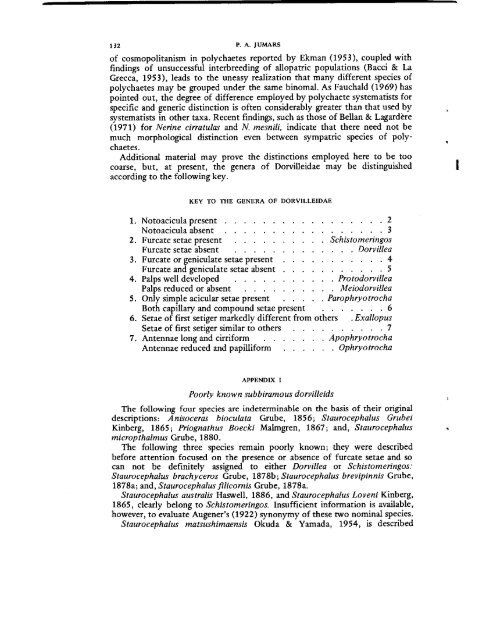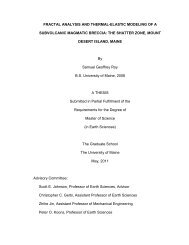Jumars, P.A. - University of Maine
Jumars, P.A. - University of Maine
Jumars, P.A. - University of Maine
Create successful ePaper yourself
Turn your PDF publications into a flip-book with our unique Google optimized e-Paper software.
132 P . A. JUMARS<br />
<strong>of</strong> cosmopolitanism in polychaetes reported by Ekman (1953), coupled with<br />
findings <strong>of</strong> unsuccessful interbreeding <strong>of</strong> allopatric populations (Bacci & La<br />
Grecca, 1953), leads to the uneasy realization that many different species <strong>of</strong><br />
polychaetes may be grouped under the same binomal . As Fauchald (1969) has<br />
pointed out, the degree <strong>of</strong> difference employed by polychaete systematists for<br />
specific and generic distinction is <strong>of</strong>ten considerably greater than that used by<br />
systematists in other taxa . Recent findings, such as those <strong>of</strong> Bellan & Lagardere<br />
(1971) for Nerine cirratulas and N. mesnili, indicate that there need not be<br />
much morphological distinction even between sympatric species <strong>of</strong> polychaetes<br />
.<br />
Additional material may prove the distinctions employed here to be too<br />
coarse, but, at present, the genera <strong>of</strong> Dorvilleidae may be distinguished<br />
according to the following key .<br />
I<br />
KEY TO THE GENERA OF DORVILLEIDAE<br />
1 . Notoacicula present 2<br />
Notoacicula absent 3<br />
2 . Furcate setae present Schistomeringos<br />
Furcate setae absent Dorvillea<br />
3 . Furcate or geniculate setae present 4<br />
Furcate and geniculate setae absent 5<br />
4 . Palps well developed Protodorvillea<br />
Palps reduced or absent Meiodorvillea<br />
5 . Only simple acicular setae present Parophryotrocha<br />
Both capillary and compound setae present 6<br />
6 . Setae <strong>of</strong> first setiger markedly different from others . Exallopus<br />
Setae <strong>of</strong> first setiger similar to others 7<br />
7 . Antennae long and cirriform Apophryotrocha<br />
Antennae reduced and papilliform Ophryotrocha<br />
APPENDIX I<br />
Poorly known subbiramous dorvilleids<br />
The following four species are indeterminable on the basis <strong>of</strong> their original<br />
descriptions : Anisoceras bioculata Grube, 1856 ; Staurocephalus Grubei<br />
Kinberg, 1865 ; Priognathus Boecki Malmgren, 1867 ; and, Staurocephalus<br />
micropthalmus Grube, 1880 .<br />
The following three species remain poorly known ; they were described<br />
before attention focused on the presence or absence <strong>of</strong> furcate setae and so<br />
can not be definitely assigned to either Dorvillea or Schistomeringos :<br />
Staurocephalus brachyceros Grube, 1878b ; Staurocephalus brevipinnis Grube,<br />
1878a ; and, Staurocephalus filicornis Grube, 1878a.<br />
Staurocephalus australis Haswell, 1886, and Staurocephalus Loveni Kinberg,<br />
1865, clearly belong to Schistomeringos . Insufficient information is available,<br />
however, to evaluate Augener's (1922) synonymy <strong>of</strong> these two nominal species .<br />
Staurocephalus matsushimaensis Okuda & Yamada, 1954, is described
















